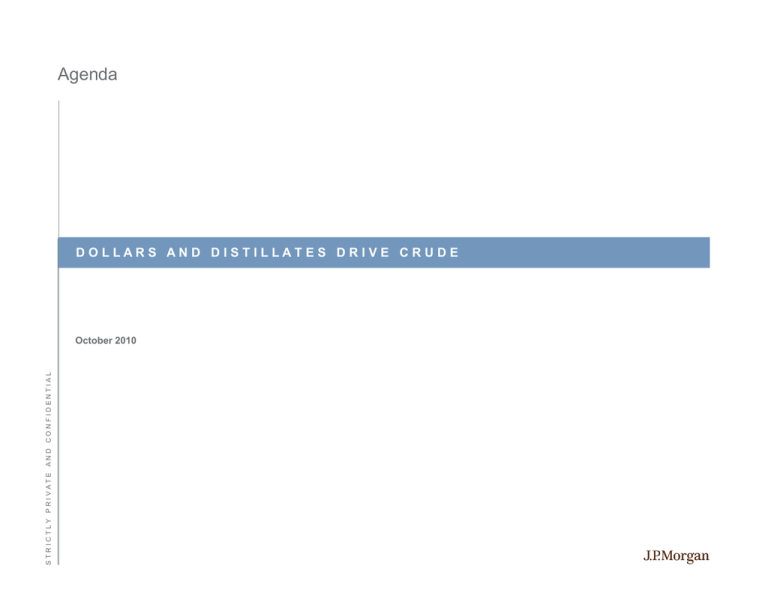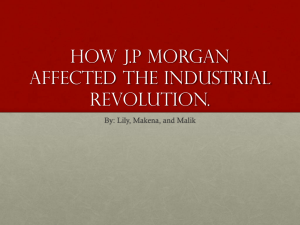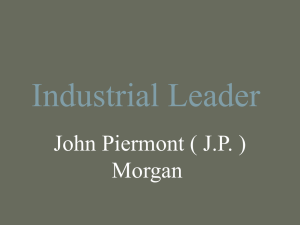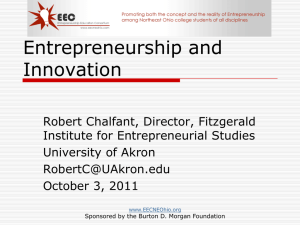Pitchbook US template
advertisement

Agenda DOLLARS AND DISTILLATES DRIVE CRUDE STRICTLY PRIVATE AND CONFIDENTIAL October 2010 QE and high liquidity risk inflation short term, but will add supply when rates rise After the Liquidity Cycle Gold $/troz Gold prices are a good barometer of interest rates, liquidity 1400 and inflation risk 1200 QE risks weakening the US dollar, adding a further 1000 stimulus to North American and Emerging Market growth 800 Linking of Fed policy to price levels, rather than growth a 600 key change in policy – could spark inflationary expectations and cause money to flow into commodities 400 200 Low interest rates enable the oil market to hold high levels 0 1983 of inventory – currently a stabilizing feature, but could become a driver of rising prices LATEST MARKET OUTLOOK 1993 1998 2003 US Dollar and Crude Oil Correlation to Resume $/EU $/bbl Bbl / troz 0.16 0.14 0.12 0.1 0.08 0.06 0.04 0.02 0 2008 Source: JP Morgan Energy Strategy, Bloomberg Oil Price is Cheap When Measured in Gold 1983 1988 Brent Crude 160 1.7 USD/EUR 140 1.6 120 1.5 100 80 1.4 60 1.3 40 1988 1993 1998 1.2 20 Oil priced in Gold 2003 0 Jan 04 2008 1.1 Jan 05 Jan 06 Jan 07 Source: JP Morgan Energy Strategy, Bloomberg Source: JP Morgan Energy Strategy, Bloomberg 2 Jan 08 Jan 09 Jan 10 Base case price forecast: Potential for major disruptions from all directions Old World: Forward price solidly anchored ■ Prior to the 2004-2008 price run-up and subsequent collapse, the forward curve was anchored around $20/bbl ■ $20/bbl was thought to be the marginal cost of supply ■ Short-term disruptions had minimal impact on longterm price views ■ OPEC sought to manage market through inventories In US$/bbl $140 $120 $100 $80 $60 $40 $20 $'99 '01 '03 '05 '07 '09 '11 Source: JPMorgan Energy Strategy New World: Disruptions will transmit across the forward price curve Event/shock (US$ Impact) Front Back (Dec 2012) Global economic shock (+ or -) +20/-30 +10/-15 Iraqi collapse or shock +30/-5 +15/-5 +40 +20 +15/-20 +15/-15 -5 -10 Substantial change to costs +5/-5 +10/-20 Unknown supply disruption +5 to +50 +0 to +30 ? ? LATEST MARKET OUTLOOK Iran turmoil China take-off or collapse Substantial interfuel substitution Other? Source: JPMorgan Energy Strategy 3 ■ Over 2004-2008 worries about longterm supply escalated ■ In 2008-2009 there was concern about the duration of the recession ■ In both cases, long-term concerns directly impacted short-term prices ■ The past year has seen a period of relative stability with the market poised at $70-80/bbl ■ Is this the calm realistic? ■ Will prices ratchet up again as we saw over 2004-2008? Flexible LNG seeks to push into high value market for oil substitutes Oil-linked Asia provides the highest value for LNG Competing Fuels 4 UK Natural Gas 7 Asia Spot LNG (Japan) 9 Asia Long Term LNG (Recent) 12 LSWR FOB Indonesia 12.50 Fuel Oil 180CST FOB Singapore 11.50 Naphtha CFR Japan 16 Minas Crude Oil 15 ■ Demand was weak in 2009 due to the crisis, but new LNG supply is pushing into the Asian market ■ Spot LNG is certainly competitive with oil...sellers seek to place flexible LNG in high value niche markets in place of oil (e.g., India, Kuwait) Global Gas Prices: What will Qatar do with its flexible volumes? Push into Asia ■ A huge question is what Qatar will do with over 30 MTPA of “flexible” LNG initially targeted at the US and UK which is now ramping up LATEST MARKET OUTLOOK ■ Korea was up over 80% yoy US$/MMBtu (approx) US Natural Gas Source: JPMorgan Energy Strategy, Bloomberg ■ Asian LNG imports grew by close to 30 percent in August versus the same period last year $3-5/MMBtu $9-13/MMBtu How will Qatar adjust to new market realities? ■ This has important implications for the oil market as it is 740 kbd of oil equivalent ■ Will it push into low value markets to compete with coal, or will it get pulled into Asia as a substitute for oil? ■ The Middle East is the latest region to emerge as a surprise LNG importer...replacing oil $3-8/MMBtu Source: JP Morgan 4 Oil demand is robust, poised to move into supply deficit Global Demand Growth Profile and Forecasts by Region, 2009-2011 461 87 44 2272 -99 911 Europe OECD North America 1631 211 ■ Still seen above trend, driven by Emerging Market demand 252 - 883 285 281 1182 FSU 166 263 82 157 59 Latin America 119 80 75 ■ World oil demand growth to moderate to 1.6 mbd in 2011 757 ■ China imports easing ■ But signs it is drawing on stocks 521 Middle-East Asia Pacific ■ Structural risks: ■ Natural gas substitution ■ Efficiency Africa World Oil Balance -1218 Global 2009 2010 2011 92.0 +10.0 +8.0 90.0 LATEST MARKET OUTLOOK Source: JPMorgan Energy Strategy ■ OPEC output has stabilised at 29.1 mbd, even assuming rising OPEC supplies, a market deficit is seen +6.0 +4.0 88.0 +2.0 86.0 ■ Still see trend GDP growth ■ Receding risks of double-dip recession ■ But Eurozone problems show they have not gone away +0.0 -2.0 84.0 -4.0 82.0 Jan 08 Stock Change To Balance Jan 09 Source: JPMorgan Energy Strategy 5 Total Product Demand Jan 10 Jan 11 Supply -6.0 Rising oil demand reflects infrastructure strains, comfort with high prices US Port Traffic Vehicle Fuel Consumption and Oil Prices 800 MPG 22.0 750 $ bbl 120 700 650 600 21.5 80 21.0 40 550 500 450 400 350 300 2002 20.5 Total Loaded Inbound 2003 2004 2005 2006 2007 2008 2009 0 Crude Oil Prices $/bbl 2010 Source: JP Morgan Energy Strategy, Port Authority Long Beach and LA Source: JP Morgan Energy Strategy, US Bureau of Transport, EIA Global Air Traffic Indicators World oil demand is coming in stronger than economic growth indicators suggest Miles Index Robust demand from Emerging Market 40 economies due to growth straining infrastructure - much in the same way as 2004 and 2008 30 20 LATEST MARKET OUTLOOK Average Miles Per Gallon 10 Signs that initial conservation response to high 0 -10 prices is waning – not surprising considering oil prices have averaged $75 bbl for five years now Freight Traffic -20 Passenger Traffic Subsidies being removed in emerging markets, -30 2003 2004 2005 2006 2007 2008 2009 but likely to be re-imposed if prices rise 2010 Source: JP Morgan Energy Strategy, IATA 6 Distillate will provide the marginal demand barrel in 2010 Non-OECD Product Demand Year-on-Year Change mbd 3 Light Ends Middle Distillate Global Product Demand Year-on-Year Change mbd 4 Fuel Oil 2 Light Ends Middle Distillate Fuel Oil 2 1 0 0 -2 -1 -2 -4 Jan-09 May-09 Sep-09 Jan-10 May-10 Sep-10 Jan-09 May-09 Sep-09 Jan-10 May-10 Sep-10 Dramatic divergence in product demand growth trends OECD Product Demand Year-on-Year Change between Emerging Markets and OECD post recession mbd 2 Light Ends Middle Distillate Light ends have driven the market higher, led by the Fuel Oil petrochemical sector Decline in light ends reflects weaker gasoline demand and end of petchem restocking Maybe too bearish LATEST MARKET OUTLOOK 0 Middle distillate demand (gasoil, diesel, jet and -2 kerosene) has shown signs of improvements in the past few months -4 Strong gasoil/diesel cracks and is good news for Jan-09 May-09 Sep-09 Jan-10 May-10 Sep-10 complex refiners 7 In an industry running at 93% capacity there is little margin for error Peak Oil Projection International Energy Agency Concern There is a need to find 3-4 mbd of new oil every year just to stand still But we have been doing that for the past decade LATEST MARKET OUTLOOK When we are less successful or demand surges, prices spike When we are marginally better, there is a downward bias to prices Future project analysis only provides clarity for the next 3-4 years Reality is there are plenty of hydrocarbons around The real questions are the price to produce them and the price to curtail demand A major concern is that even with the highest level of spare capacity for a decade, the industry is running at 96% of capacity There is little margin for error 8 Meeting emerging market growth will be a challenge Growth in Emerging Markets Indexed Global Oil Demand Growth OECD EM economies pull more oil for every extra dollar earned than mature economies. China/India/Brazil Other Non-OECD 250 EM’s have been the driver of oil demand for much of the 200 last decade, but now that they make up nearly half the world oil economy 150 100 Forecast of Chinese demand for 2010 is up 10.4%, plus another 5.3% in 2011. It will surpass the US as the worlds largest consumer by 2020 50 0 Demand growth for 2011 from India and Brazil with yoy increases of 4.4% and 4.8%, respectively. Percent Share of Global Oil Demand Chinese Oil Demand Growth 30 Chinese Oil Demand … Mln Barrels per Day 20 LATEST MARKET OUTLOOK 2013 Forecast 2001 Average 25 Other NonOECD 26% Other NonOECD 30% 15 10 China/India/ Brazil 12% 5 OECD 62% 0 2000 2004 2008 2012 Source: JP Morgan Energy Strategy, JODI, IEA 2016 2020 2024 2028 Source: JP Morgan Energy Strategy, JODI, IEA 9 China/India/ Brazil 20% OECD 50% High price and better equipment availability allows production to grow Over the past year, 2010 non-OPEC supply projections Per country Revisions (% and Vol) to 2010 Supply-ex FSU by the International Energy Agency have been revised up by 770 kbd 1 150 0.8 Russia and Azerbaijan were two major FSU 100 0.6 forecasting issues, which cancelled each other out Russia higher to new projects Azerbaijan to ongoing project delay 0.4 50 0.2 0 Supply revised higher in 41 countries, lower in 23 0 -0.2 Decline (and forecasting error) has not gone away -50 -0.4 -0.6 -0.8 Volume supply revisions kbd (RHS) Percentage supply revisions (LHS) -1 Number of countries with revisions -100 -150 Russia and USA alone present upside risk to 2011 forecast non-OPEC supply growth of 0.5 mbd Corporate guidance suggests Russian output LATEST MARKET OUTLOOK growth of 350 kbd, JPM forecast 80 kbd Downward Revisions, 23 US growth could be revised up on: lower drilling impact to Gulf of Mexico Rapid shale oil development Upward Revisions, 41 Strong pace of development in West Africa Iraq, Brazil provide two-way risks 10 OPEC will let oil prices swing between $55 and $100 per barrel OPEC uncomfortable with prices below $70 bbl, but Prompt WTI Price would only act if prices dipped below $65 bbl The time taken to gather a response could see prices dip to $55 90 80 Saudi budget needs $70 to balance – with social 70 spending growing rapidly, Saudi will be comfortable if prices rise gradually 60 Outside of a significant downward price shift, OPEC is 50 WTI 40 10 day MAV 20d MAV 30 Jan-09 Apr-09 Jul-09 Oct-09 Jan-10 Apr-10 not likely to change current quotas. Additional output from Iraq/Nigeria. Still concerned about high prices Jul-10 Source: JP Morgan Energy Strategy, JODI, IEA Geopolitical flashpoints High geopolitical risks over next six months Attacks on Iraqi northern pipeline have been stepped up during political impasse LATEST MARKET OUTLOOK Nigerian elections risk positioning by Niger Delta rebels Iranian sanctions seem to be having economic effect, but international patience wearing thin Venezuelan elections already causing surge in diesel demand as president seeks to avert rolling blackouts. Source: JP Morgan Energy Strategy, JODI, IEA 11 Refinery Crude Runs Post-Summer Runs and Margins NYMEX product cracks Refining runs are being supported by the bottom Heat Crack $/bbl half of the barrel Gas Crack Fuel Oil Crack 20 15 US refining runs have remained high despite 10 impending maintenance 5 Diesel and fuel oil demand for power generation 0 has been higher than years prior -5 -10 Diesel demand forecast has been adjusted up -15 Jan-10 Feb-10 Mar-10 Apr-10 May-10 Jun-10 Jul-10 by 150 kbd globally. Fuel oil adjusted up by a similar amount – more significant effect due to smaller pool US Refinery crude runs 2010 Surge in demand is reflected in prompt cracks rising to above $15/bbl for ULSD in Europe, its highest level since late June LATEST MARKET OUTLOOK Aug-10 Sep-10 2009 2008 2007 17.0 16.0 Northern hemisphere winter heating demand 15.0 could keep inventories tight in coming months 14.0 13.0 Market will be reluctant to draw inventory prior to 12.0 1Q11 11.0 10.0 J F M A M J Source: JP Morgan Energy Strategy, EIA 12 J A S O N D Global crude demand peaked in the summer: winter rebound seen in 4Q10 Crude Market Balance m b/d mb Crude Market Balance 74.0 150 100 73.0 50 - 72.0 -50 -100 71.0 -150 -200 70.0 -250 -300 69.0 LATEST MARKET OUTLOOK Jan-10 Jan-09 Jan-08 Stock Change (rhs) Crude Demand Crude Supply Material upward revisions to supply estimates suggest market less tight than previously thought Crude market tightness still seen peaking in July/August Thereafter seasonal maintenance points to renewed build., before year-end ramp-up in runs start the next draw 13 World product supply potential points to distillate-led tightness Tighter Fuel Oil to Pressure Upgrading Margins mbd 1.5 1.0 0.5 0.0 -0.5 -1.0 -1.5 -2.0 LPG Naphtha 2009 Gasoline 2010 Jet/kero 2011 2012 Gasoil/Diesel Fuel Oil 2013 LATEST MARKET OUTLOOK Source: JP Morgan Energy Strategy ■ Robust economic growth in Emerging Market economies, Asia in particular, underpins distillate-led demand growth ■ By contrast rising supplies of ethanol and NGL volumes will pressure gasoline cracks Continued robust naphtha demand growth provides some support to light distillate markets ■ A similar picture of rising supplies (OPEC NGL volumes) is evident in LPG markets ■ By contrast diesel/gasoil markets look set to tighten despite distillate-focused upgrading investment 14 Reported Crude Stocks have fallen by 10% from early 2009 peak OECD Commercial Crude Inventories and Floating Storage In mb 1.25 Floating OECD Land-based 1.20 1.15 1.10 1.05 1.00 LATEST MARKET OUTLOOK 0.95 0.90 Jan-09 Apr-09 Jul-09 Oct-09 Jan-10 OECD land-based crude stocks and global floating crude storage has fallen by over 100 mb since the peak in April 2009 15 Apr-10 Medium-term risks to near-term prices Spare capacity starts to fall sharply from 2011 mbd mbd 100 7 and Iraqi oil field development are the real uncertainties as we move forward 6 95 5 90 Financial stresses and 4 unemployment could drive efficiencies, but policy and high prices will be more effective and permanent 3 85 2 80 1 75 Electric vehicles are unlikely to have a significant impact on demand until post 2015 at best 0 2009 2010 Supply Capacity (LHS) 2011 2012 2013 Demand(LHS) 2014 Pace of economic growth 2015 OPEC Spare Capacity (RHS) LATEST MARKET OUTLOOK JPMorgan Medium Term Crude Oil Price Forecast Nymex WTI Crude ($/bbl) 1Q10 2Q10 3Q10 4Q10 2010 2011 2012 2013 78.88 78.05 76.00 81.00 78.50 82.50 92.50 102.50 Price forecast assumes OPEC will try to moderate increases but will the market rise much faster, to prevent a supply crunch happening? All Forecasts are period averages. Actual to date prices for 1Q10 and 2Q10 are as of July 30, 2010 16 METHODOLOGY & REFINERY OUTLOOK J.P. Morgan – Global Refinery Analysis Model J.P. Morgan’s Global Refinery Analysis Model (GRAM) is a bottom-up analysis of existing refinery capacity and confirmed investment projects The analysis covers more than one thousand individual new units adding to the existing 750 detailed refineries in the model Regional crude slates and volumes are forecast based on typical regional consumption patterns and forecast changes to crude quality NGL supply volumes are assumed to be a substitute for crude in the global crude market Implications for the residue balance in particular Supply analysis assumes OPEC will maximize production of non-quotas barrels ahead of crude The GRAM uses 50 crude assays to analyze output from the initial distillation of the crude. The model then runs these outputs through secondary processing units and aggregates the output into seven finished product categories Model assumes that most capital intensive units are filled first i.e. cokers are filled before visbreakers The impact of the new capacity additions are shown through a comparison of total product supply of these seven product categories against JP Morgan’s detailed product demand model Regional and global product market balances are then calculated including other sources of supply including NGLs and biofuels 17 Regional refining capacity growth: the Americas; EMEA; Asia-Pacific Global refining industry set for substantial growth in 20102014 period Growth is led by regional champions China in Asia Saudi Arabia in the Middle East The US and Brazil in the Americas METHODOLOGY & REFINERY OUTLOOK Global Refining Capacity Growth 2010-2014 (mbd) 1.7 1.5 3.0 2.3 1.9 Ongoing investment in upgrading capacity will Further boost the supply of light clean products Continue to tighten fuel oil markets Puts upgrading margins under pressure CDU Regional variations will become critical to refinery profitability European and Japanese refineries faces the greatest pressure to close capacity Falling regional demand keeps profit generation under intense pressure Rising biofuels supplies globally will further undermine potential returns Upgrading Source: JP Morgan Energy Strategy, Wood Mackenzie 18 1.6 Regional upgrading capacity growth: the Americas; EMEA; Asia-Pacific Global Crude Distillation Capacity Growth 2010-2014 1.0 Global Upgrading Capacity Growth Profile 2010-2014 1.5 1.0 1.0 0.5 1.0 1.0 0.5 0.5 0.5 1.0 0.5 - - - 0.5 2010 2010 2012 2014 2012 2010 2012 2014 2014 - 2010 2012 METHODOLOGY & REFINERY OUTLOOK 2012 2014 2014 Source: JP Morgan Energy Strategy, Wood Mackenzie Source: JP Morgan Energy Strategy, Wood Mackenzie ■ 2010 - Asia Pacific and Middle East lead CDU capacity increase Driven by supply security concerns in China, India OPEC expansions driven by: ■ Energy security ■ Desire to maximize revenue from the barrel ■ Market control ■ Brazil, Mexico and the US bolster the Americas ■ Upgrading capacity additions concentrated in next three years 19 2010 2012 2014 Oil market outlook : Conclusions Linking of Fed policy to price levels, rather than growth a key change in policy – could spark inflationary expectations and cause money to flow into commodities Low interest rates enable the oil market to hold high levels of inventory – currently a stabilizing feature, but could become a driver of rising prices The recent decision to allow output to drift higher and lower stock levels adds weight to extreme views on higher underlying decline rates and lower spare capacity World oil demand growth of 2.2mbd will moderate to 1.6 mbd in 2011 Still seen above trend, driven by Emerging Market demand and healthy EM GDP growth. Light ends have driven the market higher, led by the petrochemical sector Middle distillate demand (gasoil, diesel, jet and kerosene) has overtaken gasoline/naphtha as transportation gain become the dominant feature of world oil demand growth. A major concern for the industry and OPEC is that even with 6mbd of spare, the industry is running at 93% of capacity; suggesting there is little margin for error OPEC output has stabilised at 29.1 mbd, and upcoming OPEC meeting is unlikely to see any LATEST MARKET OUTLOOK departure from current script. The market seems happy to anchor prices in the $80-100/bbl long-term, but is this rational? Supply and demand shocks could quickly force a re-appraisal of long-term equilibrium prices if circumstance change. 20 North American capacity expansion driven by the US US refiners continue to adapt to rising supplies of heavy sour crude/bitumen from Canada, rising Shale Oil production and the Middle East’s increasingly sour crude slate Nearly 75% of US capacity additions relate to projects to increase the ability to process heavy sour crude Key projects include: US Coking Capacity Growth Projects Motiva Port Arthur—325 kbd new crude capacity in 2012 Marathon Garyville—180 kbd new crude capacity on stream in 2010 Projects involve substantial expansion of upgrading units METHODOLOGY & REFINERY OUTLOOK However, these investment decisions, while still robust in term of potential economics ignore the changing landscape of the US crude market—notably the rise of better quality oil from the emerging shale oil plays Source: JP Morgan Energy Strategy, Wood Mackenzie 21 World product supply potential points to distillate-led tightness Tighter Fuel Oil to Pressure Upgrading Margins mbd 1.5 1.0 0.5 0.0 -0.5 -1.0 -1.5 -2.0 LPG Naphtha 2009 Gasoline 2010 Jet/kero 2011 2012 Gasoil/Diesel Fuel Oil 2013 PRODUCT BALANCES Source: JP Morgan Energy Strategy ■ Robust economic growth in Emerging Market economies, Asia in particular, underpins distillate-led demand growth ■ By contrast rising supplies of ethanol and NGL volumes will pressure gasoline cracks Continued robust naphtha demand growth provides some support to light distillate markets ■ A similar picture of rising supplies (OPEC NGL volumes) is evident in LPG markets ■ By contrast diesel/gasoil markets look set to tighten despite distillate-focused upgrading investment 22 North American supply potential — gasoline imports to diminish North American Gasoline Market to Become More Balanced mbd 0.4 0.2 0.0 -0.2 -0.4 -0.6 -0.8 -1.0 -1.2 -1.4 LPG Naphtha 2009 Gasoline 2010 Jet/kero 2011 2012 Gasoil/Diesel Fuel Oil 2013 PRODUCT BALANCES Source: JP Morgan Energy Strategy ■ Regional gasoline import requirement diminishes due to falling demand (despite Mexico) ■ Rising ethanol supplies help rebalance market ■ Current diesel exports are eroded by strong economic growth supporting diesel demand ■ However we have assumed US refiners do not radically alter their operating mode – i.e. they remain focused on max gasoline 23 Upgrading capacity to tighten the fuel oil balance in the coming years Global Fuel Oil Supply and Demand Balance mbd 1.0 0.5 0.0 -0.5 -1.0 -1.5 -2.0 2009 2010 2011 2012 2013 Source: J.P. Morgan Energy Strategy With the move towards cleaner/lower sulfur fuels, demand for the bottom cut of the barrel has continued to trend lower over the years despite strength in other product groups However, we expect the fuel oil balance to tighten considerably over the next several years as the current refinery buildout cycle is expected to add a considerable amount of upgrading capacity Much of the new refining capacity (the bulk in non-OECD Asia) is expected to be rather sophisticated, with the ability to reprocess much of the fuel oil produced into more desirable (and higher priced) middle and light end products In Europe and North America, the inability to build new greenfield refineries has led to additions of secondary units to existing infrastructure to produce a lighter product slate, reducing fuel oil yields European supply potential — gasoline exports remain a threat to region Diesel-Biased Demand Leaves Region Vulnerable to Rationalization mbd 1.4 1.2 1.0 0.8 0.6 0.4 0.2 0.0 -0.2 -0.4 -0.6 -0.8 LPG Naphtha 2009 Gasoline Jet/kero 2010 2011 Gasoil/Diesel 2012 Fuel Oil 2013 PRODUCT BALANCES Source: JP Morgan Energy Strategy ■ Despite lower crude run assumptions, declining regional demand leaves European refineries exposed to competition from rising Asian export volumes (particularly from India) ■ In contrast to North America, Europe’s product balance moves more out of line with demand ■ Capacity rationalization remains a real risk given low complexity many regional refineries 24 Conclusions: global refining and product supply Refiners globally are over-investing in new capacity, and particularly upgrading capacity This is the area that has provided strong returns over the past 20 years, but by virtue of overinvestment will provide less of a competitive advantage in the future World refinery capacity and upgrading expansions to constrain refining margins for the next five years Upgrading capacity to keep fuel oil margins tight and narrow differentials between light/sweet, and heavy/sour crude oil prices Bulk of new capacity taking place in Asia and Middle East—the area of greatest demand growth Low clean freight rates to open up wider scope for product trade when Asia becomes over-supplied Refining profitability is therefore likely to be strongly influenced by location factors—particularly access to low cost crudes Atlantic Basin crude supplies to be tightened by ongoing draw from Asia, Russian preference for supplies via ESPO pipeline, ongoing decline in North Sea PRODUCT BALANCES US refiners continue to adapt to rising supplies of heavy sour crude/bitumen from Canada, rising shale oil production and the Middle East’s increasingly sour crude slate Significant investment in additional coking capacity will allow refiners to run heavier crude slates— positioning themselves to capture lower cost feedstock’s on the Gulf Coast and potentially the US Midwest But many of these investment plans were signed off before the recent surge in shale oil production 25 Agenda J.P. MORGAN GLOBAL COMMODITIES GROUP STRICTLY PRIVATE AND CONFIDENTIAL October 2010 26 J.P. Morgan Global Commodities – Growth Story Investing in our platform J.P. Morgan has made significant investments in building out and diversifying our Global Commodities platform and capabilities - organically and through strategic acquisitions, such as RBS Sempra J.P. Morgan's Global Commodities Group offers clients a comprehensive set of market making, structuring, risk management, financing and warehousing capabilities across the full spectrum of commodity asset classes Key transactions accelerate J.P. Morgan’s growth Completed acquisition Acquired UBS Acquired Bear Energy GLOBAL COMMODITIES OVERVIEW J.P. Morgan expands energy trading platform organically J.P. Morgan corporate focus on developing market leading energy trading platform 2005-2006 Co-founded the New as part of J.P. Morgan’s acquisition of Bear Stearns Acquired ClimateCare, a leading originator of carbon offsets Commodities Canada Ltd and UBS AG’s global agricultural business Acquired EcoSecurities Group plc, a global leader in the carbon credit market Completed acquisition of RBS Sempra’s North America natural gas and power trading portfolios in October York Mercantile Exchange’s Green Exchange 2006 of RBS Sempra’s metals, oil, coal, plastics, agricultural, and concentrates; nonU.S. emissions, European power and gas and investor products assets from the Royal Bank of Scotland and Sempra Energy in July 2008 27 2009 2010 J.P. Morgan Global Commodities Group Commodity risk expertise is interlinked with firm wide capabilities Corporate Risk Management: J.P. Morgan provides risk management solutions for clients hedging commodities exposure - clients covered include consumers, producers, refiners and traders of metals, energy and agriculture/softs Market Intelligence: J.P. Morgan affords clients a wide view of the commodity markets given J.P. Morgan’s diverse client base and distributes industry leading research in all commodities Commodity Related Financing: J.P. Morgan provides corporate finance solutions for clients seeking to buy or sell commodity assets or to leverage assets as collateral for financing transactions Leverage of J.P. Morgan’s internal resources (Research, Lending, Equity and Debt Underwriting): J.P. Morgan’s clients have access to J.P. Morgan’s complete platform Up to date on latest industry and product trends Strong customer relationships: J.P. Morgan works closely with customers to design the most appropriate solution in the futures, cash, and over-the-counter commodities markets GLOBAL COMMODITIES OVERVIEW J.P. Morgan stands out Commodity leader: J.P. Morgan is at the leading edge of product development and risk management in the Commodity and Currency product space Risk transfer: J.P. Morgan takes significant principal risk, publishes leading research, and works on a global structure to ensure that our customers get the best service available J.P. Morgan’s vast ability to take risk: Long-dated risk: J.P. Morgan can take on commodity risk beyond normal market tenors Outsized Risk : J.P. Morgan has strong market risk lines so can warehouse sizable positions Exotic risk: J.P. Morgan has the ability to trade products that many other banks do not Correlation risk: J.P. Morgan has a large correlation book and has the ability to trade exotic correlation 28 J.P. Morgan Covers Commodities Across the Supply Chain Research Futures & Options Metals, Bulk Commodities OTC Metals, Energy and Ags Listed Futures and Options Energy and Power Warehousing Risk Specialist Trading Desks Grains and Agricultural Structured Products Global Clearing Solutions Technical Analysis Long Dated Contracts Electronic Trading Energy and Power Coal Electricity Natural Gas Gasoline GLOBAL COMMODITIES OVERVIEW Global Commodities Crude Oil NGLs Transportation Freight Base Metals Precious Metals Agricultural Weather Steel Gold Cattle Temperature Nickel Silver Zinc Platinum Dairy Precipitation Grains Wind Soybeans Tin Copper Palladium Wheat Corn Aluminium Softs Lead Coffee Aluminium Alloy Sugar NASAAC Cotton 29 Hurricanes Environmental Markets Carbon allowances and offsets (e.g., RGGI; EUAs; CERs; VERs) Sunshine Sulphur Dioxide Crop Yields Nitrogen Oxides Renewable Energy Credits Plastics Ethylene Polyethylene Polypropylene J.P. Morgan – Oil Trading Global Oil Trading Headcount by Location – 24 hour coverage London 18 Stamford 12 Calgary 6 PHYSICAL AND FINANCIAL OIL CAPABILITIES New York 13 Geneva/ Zug 5 Houston 4 Singapore 16 In addition, there are over 20 waterborne and pipeline logistics experts spread across these locations 30 Global Footprint Worldwide Locations From metals and energy to environmental and agricultural commodities, our nearly 2,000 professionals in more than 10 countries operate at the center of the commodity markets. In addition to our office locations, our Henry Bath warehousing franchise operates more than 100 individual warehouses locations in 11 countries Liverpool Oxford Oslo London* Stamford Calgary Stockholm Holland New York* Beijing Germany Chicago Washington DC Shanghai Maryland Seoul Hong Kong Tokyo Houston* Madrid Istanbul GLOBAL COMMODITIES OVERVIEW Singapore* Geneva Sao Paulo** Dubai Zug Mumbai Italy Combined Location JPM GCG Only Center Johannesburg** Sydney RBS-S Only Center * Major hub ** Expected in 2nd half of 2010 31 J.P. Morgan’s Global Oil Physical Asset Overview London New York Calgary Geneva/ Zug PHYSICAL AND FINANCIAL OIL CAPABILITIES Houston Singapore Time Chartered Vessels Storage Facilities J.P. Morgan can provide physical off take, delivery, storage, shipping and blending solutions across most petroleum products, enabled by strong trading, operational, and functional support expertise Unique market position because much of the physical activity cannot be achieved in the financial market (e.g., float a ship without a sale, unmatched physical longs and shorts in different market areas, trade non-hub locations) Participate in both wet and dry freight 32 Select Oil Team Members Jeff Frase, Managing Director Ken Krug, Executive Director Dean Bristow, Executive Director Kirk Kinnear, Executive Director Jay Miller, Executive Director PHYSICAL AND FINANCIAL OIL CAPABILITIES David Scholten, Executive Director Ira Eisenstein, Executive Director Andy Kelleher, Managing Director Greg Hebrank, Executive Director Max Strongin, Executive Director Dean Craig, Executive Director Jeff Frase joined J.P. Morgan and the GCG management team in October 2008 as the head of Global Oil Trading, based in New York. He joins us from Lehman Brothers, where he ran Global Oil Trading for one year. Prior to Lehman, Jeff was a part of Goldman Sachs' Commodities franchise for 17 years, where he had most recently been head of Global Crude Oil and Derivatives trading. Ken Krug joined J.P. Morgan in July 2010 and will run the North American physical crude oil trading business. Prior to joining, he spent four years at Goldman Sachs running the North American physical crude oil business. Ken also started the Canadian physical crude oil trading business during his time at Goldman. In addition, Ken has worked in the refining space doing supply and trading at Suncor Energy. Dean Bristow joined J.P. Morgan in 2010 with the acquisition of Sempra. He has spent the past year at Sempra running the Canadian Crude Oil book, trading Canadian physical grades, and managing the physical storage portfolio. Previously at Sempra, Dean managed business development for North America physical oil and the Canadian wellhead business. Dean has over 21 years in the energy business. Kirk Kinnear joined J.P. Morgan in 2010 with the acquisition of Sempra. He has over 30 years experience in oil trading with Phibro Energy, Hess Energy Trading and Sempra. Kirk was responsible for supplying crude to refineries in the mid-continent with Farmland, and the US Gulf Coast with Phibro USA. He has worked on the trans-Alaska Pipeline and has experience as a lease crude buyer in the Mid-Continent and the Rockies. Kirk currently serves as Secretary on the Board of Directors and NYMEX Foundation. Jay Miller joined J.P. Morgan in 2010 with the acquisition of Sempra. He has been in the oil industry since 1975 and began his career trading at ConocoPhillips. Jay helped start the crude oil trading group at Drexel, Burnham, Lambert until the energy trading operations were sold to Sempra Energy. Jay has spent most of his career managing domestic crude oil trading operations and has extensive experience on both the physical and financial side of the business. Jay is also a member of the Board of Directors of the New York Mercantile Exchange. David Scholten joined J.P. Morgan in 2010 with the acquisition of Sempra. He joined Sempra in 2005 as domestic crude oil trader. Prior to that, David was with Shell Trading US Co where he held various positions as a domestic crude oil trader. Before trading, David spent 8 years in refining as a chemical engineer with Star Enterprise. Ira Eisenstein joined J.P. Morgan in April 2008 as a crude oil trader. Ira started his career as a trader at Phibro Energy and also worked in the tanker industry. Prior to joining J.P. Morgan, Ira was an Executive Director responsible for crude oil trading at Morgan Stanley for 17 years. Andy Kelleher joined J.P.Morgan in August 2009 as the head of North American Products, bringing with him 30 years of extensive experience trading physical crude and products. His previous roles include President of ConocoPhillips Supply and Trading, Vice President of Tosco Supply and Trading, Phillips Petroleum Company, Sunoco Supply and Trading, and The Marc Rich Trading Company. Greg Hebrank joined J.P. Morgan in 2010 with the acquisition of Sempra. At Sempra, Greg managed North American light products trading (gasoline, ethanol, distillates, jet) for the past 6 years. Prior to Sempra, Greg worked for BP, Koch, Shell and El Paso Corporation in light products trading. Max Strongin joined J.P. Morgan in 2010 with the acquisition of Sempra. Max joined the Sempra fuel oil desk in 2002 and traded financial fuel oil. Max is currently an Executive Director at J.P. Morgan trading financial and physical fuel oil based in Stamford. Dean Craig joined J.P. Morgan in 2010 with the acquisition of Sempra. He has been with Sempra for five years, and currently runs the physical Natural Gas Liquids book. Dean has traded Natural Gas Liquids for 10 years. Prior to that, Dean traded refined products including unleaded gasoline, jet, and distillate for 8 years. In total, Dean has been in the trading business for 20 years. 33 J.P. Morgan named “Derivatives House of the Year” by EnergyRisk Energy Risk’s Derivatives House of the Year J.P. Morgan won EnergyRisk’s Derivatives House of the Year in June, 2010 The magazine highlighted “a year of innovation in which it executed a number of ground-breaking deals” as key components of J.P. Morgan’s industry dominance J.P. MORGAN GLOBAL COMMODITIES CREDENTIALS Recognized Products “Organic growth and a raft of acquisitions” have led to a “growing foothold” in the commodities industry Several structured transactions, in particular, showcased J.P. Morgan’s ever-growing leadership in commodities Strategic fuel hedge programme for the Republic of Panama Rainfall-contingent power hedge for a South American-based utility company Expansion of price-making capabilities throughout Asia Tokyo Commodity Exchange Bear Energy Japanese crude cocktail ClimateCare Regional crudes UBS Canadian energy and global agriculture businesses Agriculture products EcoSecurities Regional coal Sempra global metals and oil businesses Regional Power "What's starting to change are clients' views of J.P. Morgan. We didn't just flip a switch and one day it happened. We have been deliberate in our growth strategy. We are now in parts of the world that hadn't been a major focus for our commodities team, such as Central and Latin America, the Middle East, Africa and Asia. Over the course of the past few years, our focus in energy and other commodities has really been extending beyond financial and flow products to more physical and structured transactions.“ -Mike Camacho, Global Head of Commodity Sales EnergyRisk; June, 2010 34







